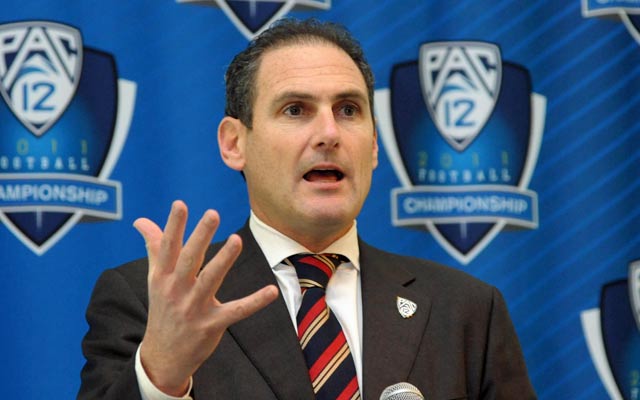 |
| Larry Scott and the Pac-12 look to follow in the Big Ten's footsteps with a TV network. (Getty Images) |
When the Pac-12 Network debuted in San Diego on Wednesday, there were more subscribers in that market to the Big Ten Network.
Don’t ever underestimate the Buckeye surfer demographic.
This is not to disparage the Pac-12 Network or elevate the Big Ten Network. It is a call for calm. The Pac-12’s network launched Wednesday like a digital hydra. There are seven of them bound for glory and riches, the Pac-12 believes. The media, for the most part, concurs. This space merely questions.
To this point the P12N has had their new product sufficiently promoted. Commissioner Larry Scott is brilliant and articulate. His expertise has made sure the conference will have the rights to technology that has not been invented yet.
But to date, the Big Ten Network has been the one/1/uno college-centric network that has made it.
Meanwhile, the Pac-12 Network is less than a day old. While its success has been trumpeted, like any start-up it comes with a disclaimer: long-term profitability is not assured. As of now the Big Ten Network remains the standard. It turns five this month having made a profit in its first year. It proudly attracted 30 million subscribers within 30 days of it launch. It currently has 51 million subscribers and is truly a national network
Simply put, the Big Ten Network has blood under its fingernails having hammered out cable system deals literally door-to-door in the early days.
“I do admire what the Big Ten has done …,” Pac-12 Enterprises head Gary Stevenson told the Los Angeles Daily News. “but I do think there are advantages to doing something like this from scratch.”
From scratch? Check that blood under the Big Ten fingernails. The Pac-12 Network's biggest initial advantage was knowing a conference network could be launched.
The Pac-12’s national network -- there are also six regionals -- wasn’t available in Orange County, Calif. on Cox Cable, one of the network’s four founding partners. The OC is arguably the heart and soul of the conference’s television footprint. (To be fair, the national net is available on other cable carriers and Cox is taking the Pac-12 Southern California regional network. That’s their prerogative in the P12N’s ala carte-type set up.)
I'm confused, and I'm not the only one. That's not necessarily bad things for the new network. It’s just how you view them. And how you view them is what this college networking thing has been about. With that one major exception, they have been big on promise and short on delivery.
The Pac-12 Network launched Wednesday hoping one day to help deliver perhaps $30 million per year to member schools. I was one of those who wrote that figure in a blog months ago convinced that the Pac-12 wasn’t just new, it was a new invention. But at the moment, the conference can’t tell you for sure how many subscribers it has.
Don’t advertisers need to know such things? Not really. The large majority of revenue in such ventures is made through subscription fees. Those are reflected on your monthly cable bill. You want some channels, you don’t want others.
It in the industry it’s called value proposition.
“If you want to go out on a limb and start a network you’ve got to make sure you have a value proposition that is going to be something cable carriers HAVE to HAVE,” said one college media analyst. “Time Warner has gone without the NFL Network forever. Time Warner is saying -- to have access to a couple of [NFL] games is not worth spending billions of dollars.”
And yet Time Warner has said yes as well to the Pac-12 Network as one of its four founding cable partners. Good for them. Carriage ultimately reflects the consumers’ desires. But The Mtn. died. The Longhorn Network has been a flop to this point. The Big 12 decided five years ago not to do a network. The SEC intends to launch a network (code named: Project X) but its launch may be years away.
One person familiar with the Pac-12 Network projected an eventual subscriber base of 15 million to 18 million, about a third of the Big Ten Network. What’s the number, today, at launch? Maybe 10 million.
The Pac-12 has a network on the come. The Big Ten is an equity partner with Fox. The deal is throwing off at least a nine-figure profit to be distributed to member schools each year. The Big Ten Network is better today, but does it matter? Will it matter?
The Pac-12 Network has taken a unique approach. With those seven networks, it’s almost like a boutique where cable systems can mix and match. But all the consumer really wants to know is: Can I get it and on what channel? If they can’t get a straight answer they won’t watch -- and/or wonder why their cable bill has increased.
In San Diego and other markets, the Big Ten Network has a strong hold outside its footprint thousands of miles away. Unlike the Pac-12 Network it is on both major satellite providers -- Dish and DirecTV -- and major telecommunication providers. DirecTV alone has 18 million subscribers.
Those satellite and telco deals are coming soon, and they will be lucrative the Pac-12 says. The whole idea was to get cable carriage first for a network that is owned and operated by the league. But in a place like Los Angeles the cable-only penetration rate is about 45 percent. (Include satellite and other devices and the L.A. “wire” rate is 88 percent.)
The Big Ten partnered with Fox and grabbed subscribers early on -- 10 million in the first week. Commissioner Jim Delany has been proud to claim that at the end of the 20-year deal, the Big Ten will have made $4 billion-$5 billion in rights fees and profits.
Can the Pac-12 match? Does it want to match? Does it matter? All we, as consumers, should care about is if we can see it, how much it’s going to cost us and the quality. By all accounts, the Pac-12 Network is going to be high-quality. Analyst Rick Neuheisel was made for TV. Just ask UCLA.
Kidding, kidding.
Meanwhile, the Big Ten Network has been nominated for Emmys. Its series The Journey is appointment viewing. Point being, if we’re going to get all gushy about the Pac-12 Network, let’s at least admit the origin of the template.
“This [Pac-12] thing is a home run,” said Chris Bevilacqua, noted media consultant who helped put the Pac-12 deals together. “They’ve got three times the amount of content because they’ve regionalized. It’s a different product. It’s built for a TV Everywhere marketplace. It’s a hybrid, national, regional, local, digital TV Everywhere offering. We had the benefit of designing it that was reflective of the multi-channel ecosystem.”
But is it the future? Essentially, those Pac-12 Network football games (and to a lesser extent basketball) will drive interest. Any start-up network is only as good as its football and basketball content. A closer look at early Pac-12 Network games, though, shows a lot of Southern Utahs and Nicholls States on the schedule. The best early game is arguably Cal at USC on Sept. 22.
In that sense, the schedule looks a lot like the Big Ten’s. Jim Delany had the foresight to capitalize on Big Ten fan interest to launch is network. The league footprint boasts a quarter of the U.S. population. Will Pac-12 fans be as rabid? More than one SoCaler has reminded me that on a sunny Saturday, Angelenos are just as likely to head to the beach than to the den to watch Stanford-Utah.
So far, the business plan has been brilliant. The Pac-12 was so undervalued in the past that no one knew what it was worth. Scott maxed out that worth last year signing that ESPN/Fox deal that, for now, guarantees the Pac-12 the most lucrative rights fees in college sports.
That, and the network, help make the following possible: Eventually every football and basketball game will be televised live.
While subscriber numbers may not be high now -- example: satellite-only subscriber and Washington State coach Mike Leach cannot get the Pac-12 Network -- Scott is banking on the future.
For now, the TV Everywhere component includes content on PCs, IPads and IPhones. The Big Ten Network already has similar distribution with BTN2Go. The Big Ten Digital Network launched in 2011.
It is great drama played out with ratings points as weapons, press releases used as karate kicks. It doesn’t matter who is “better.” We win. There is more football (and basketball) for us to watch -- complete with fine print translated at the bottom of your cable bill each month.
Get ready to open your wallet.




















